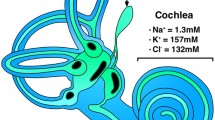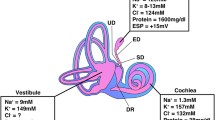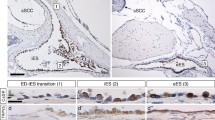Summary
We measured Ca++ activity in the different parts of the endolymphatic space by using a doublebarrelled electrode with calcium liquid ionic exchanger. In the region of the endolymphatic sac, Ca++ activity (4.7×10−4 M) was much higher than in the cochlear duct (2.7×10−5 M) and semicircular canal (2.6×10−4 M). These findings suggest that Ca++ may also have a significant role in abnormal states.
Similar content being viewed by others
References
Bosher SK, Warren RL (1978) Very low calcium content of cochlear endolymph, an extracellular fluid. Nature 273:377–378
Meyer zum Gottesberge AM, Kaufmann R (1986) Is an imbalanced calcium-homeostasis responsible for the experimentally induced endolymphatic hydrops? Acta Otolaryngol (Stockh) (in press)
Morgenstern C, Mori N, Amano H (1984). Pathogenesis of experimental endolymphatic hydrops. Acta Otolaryngol (Stockh) [Suppl] 406:56–58
Ninoyu O, Meyer zum Gottesberge AM (1986) The change of Ca++ activity and DC potential in experimental endolymphatic hydrops. Arch Otolaryngol (in press)
Author information
Authors and Affiliations
Rights and permissions
About this article
Cite this article
Ninoyu, O., Meyer zum Gottesberge, A.M. Ca++ activity in the endolymphatic space. Arch Otorhinolaryngol 243, 141–142 (1986). https://doi.org/10.1007/BF00453767
Received:
Accepted:
Issue Date:
DOI: https://doi.org/10.1007/BF00453767




